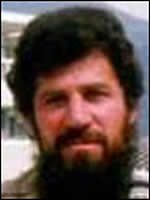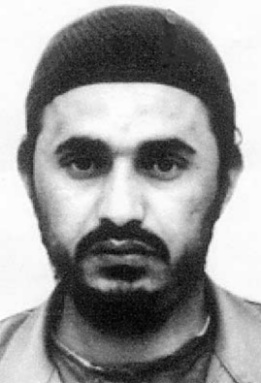
Al-Qaeda is a pan-Islamist militant organization led by Sunni jihadists who self-identify as a vanguard spearheading a global Islamist revolution to unite the Muslim world under a supra-national Islamic caliphate. Its membership is mostly composed of Arabs but also includes people from other ethnic groups. Al-Qaeda has mounted attacks on civilian, economic and military targets of the U.S. and its allies; such as the 1998 US embassy bombings, the USS Cole bombing, and the September 11 attacks.

Osama bin Laden was a Saudi Arabian-born Islamist dissident and militant leader who was the founder and first general emir of al-Qaeda, a militant terrorist organization espousing Islamism, pan-Islamism and jihadism. Bin Laden participated in the Afghan mujahideen's jihad against the Soviet Union during the Soviet–Afghan War, and supported the Bosnian mujahideen during the Yugoslav Wars. Opposed to the United States' foreign policy in the Middle East, Bin Laden declared war on the U.S. in 1996. He supervised international terrorist attacks against Americans, including the September 11 attacks inside the U.S. in 2001.

Ayman Mohammed Rabie al-Zawahiri was an Egyptian-born pan-Islamist militant and physician who served as the second general emir of al-Qaeda from June 2011 until his death in July 2022. He is best known for being one of the main orchestrators of the September 11 attacks.

The Special Activities Center (SAC) is a division of the United States Central Intelligence Agency responsible for covert and paramilitary operations. The unit was named Special Activities Division (SAD) prior to 2015. Within SAC there are two separate groups: SAC/SOG for tactical paramilitary operations and SAC/PAG for covert political action.

Jama'at al-Tawhid wal-Jihad, abbreviated as JTJ or Jama'at, was a Salafi jihadist militant group. It was founded in Jordan in 1999, and was led by Jordanian national Abu Musab al-Zarqawi for the entirety of its existence. During the Iraqi insurgency (2003–11), the group became a decentralized network with foreign fighters with a considerable Iraqi membership.

The Saddam Hussein and al-Qaeda link allegations were based on false claims by the United States government alleging that a secretive relationship existed between Iraqi president Saddam Hussein and the Sunni pan-Islamist militant organization al-Qaeda between 1992 and 2003. U.S. president George W. Bush used it as a main reason for invading Iraq in 2003.
On 13 January 2006 the Central Intelligence Agency fired missiles into the Pakistani village of Damadola in the Bajaur tribal area, near the Afghan border, killing at least 18 people. United States officials later admitted that no al-Qaeda leaders perished in the strike and that only local villagers were killed. The attack purportedly targeted Ayman al-Zawahiri, second-in-command of al-Qaeda after Osama bin Laden, who was thought to be in the village.
Saʻd bin ʾUsāmah bin Muḥammad bin ʿAwaḍ bin Lādin, better known as Saad bin Laden, was one of Osama bin Laden's sons. He continued in his father's footsteps by being active in Al Qaeda, and was being groomed to be his heir apparent. He was killed in an American drone strike in 2009.

Nashwan Abdulrazaq Abdulbaqi al-Tamir, better known as Abd al-Hadi al-Iraqi is an Iraqi member of Al-Qaeda who is now in United States custody at Guantanamo Bay detention camp in Cuba.
Osama bin Laden, the founder and former leader of al-Qaeda, went into hiding following the start of the War in Afghanistan in order to avoid capture by the United States for his role in the September 11 attacks, and having been on the FBI Ten Most Wanted Fugitives list since 1999. After evading capture at the Battle of Tora Bora in December 2001, his whereabouts became unclear, and various rumours about his health, continued role in al-Qaeda, and location were circulated. Bin Laden also released several video and audio recordings during this time.
This article is a chronological listing of allegations of meetings between members of al-Qaeda and members of Saddam Hussein's government, as well as other information relevant to conspiracy theories involving Saddam Hussein and al-Qaeda.

On May 2, 2011, the United States conducted Operation Neptune Spear, in which SEAL Team Six shot and killed Osama bin Laden at his "Waziristan Haveli" in Abbottabad, Pakistan. Bin Laden, who founded al-Qaeda and masterminded the September 11 attacks, had been the subject of a United States military manhunt since the beginning of the War in Afghanistan, but escaped to Pakistan—allegedly with Pakistani support—during or after the Battle of Tora Bora in December 2001. The mission was part of an effort led by the Central Intelligence Agency (CIA), with the Joint Special Operations Command (JSOC) coordinating the Special Mission Units involved in the raid. In addition to SEAL Team Six, participating units under JSOC included the 160th Special Operations Aviation Regiment (Airborne) and the CIA's Special Activities Division, which recruits heavily from among former JSOC Special Mission Units.

Abu Musab al-Zarqawi, born Ahmad Fadeel Nazal al-Khalayleh, was a Jordanian militant jihadist who ran a training camp in Afghanistan. He became known after going to Iraq and being responsible for a series of bombings, beheadings, and attacks during the Iraq War, reportedly "turning an insurgency against US troops" in Iraq "into a Shia–Sunni civil war". He was sometimes known by his supporters as the "Sheikh of the slaughterers".
Atiyah Abd al-Rahman, born Jamal Ibrahim Ashtiwi al Misrati, was reported by the US State Department to be a senior member of al-Qaeda and a member of the Libyan Islamic Fighting Group and Ansar al-Sunna. His name may be rendered in English as Atiyah Abdur-rahman or Atiyah Abdul-Rahman or in other ways. After his death he was described in Foreign Policy as a renaissance man for "combining both strategic and ideological savvy".

The Bin Laden Issue Station, also known as Alec Station, was a standalone unit of the Central Intelligence Agency in operation from 1996 to 2005 dedicated to tracking Osama bin Laden and his associates, both before and after the 9/11 attacks. It was headed initially by CIA analyst Michael Scheuer and later by Richard Blee and others.
This is a list of activities ostensibly carried out by the U.S. Central Intelligence Agency (CIA) within Pakistan. It has been alleged by such authors as Ahmed Rashid that the CIA and ISI have been waging a clandestine war. The Afghan Taliban—with whom the United States was officially in conflict—was headquartered in Pakistan's Federally Administered Tribal Areas during the war and according to some reports is largely funded by the ISI. The Pakistani government denies this.

FDD's Long War Journal (LWJ) is an American news website, also described as a blog, which reports on the War on terror. The site is operated by Public Multimedia Incorporated (PMI), a non-profit media organization established in 2007. PMI is run by Paul Hanusz and Bill Roggio. Roggio is the managing editor of the journal and Thomas Joscelyn is senior editor. The site is a project of the Foundation for Defense of Democracies, where both Roggio and Joscelyn are senior fellows.

Bill Roggio is an American commentator on military affairs, and the managing editor of The Long War Journal. Prior to leading a team of online commentators, Roggio published the online weblog The Fourth Rail. Roggio was an active duty soldier in the United States Army in the 1990s.
Shadi Abdalla is as an associate of Abu Musab al Zarqawi, the leader of al Qaeda in Iraq, and as having knowledge of some of al Qaeda's most important Afghan training camps.
Arshad Khan, commonly known as Abu Ahmed al-Kuwaiti was a Kuwaiti-born Pakistani courier for Osama bin Laden.











